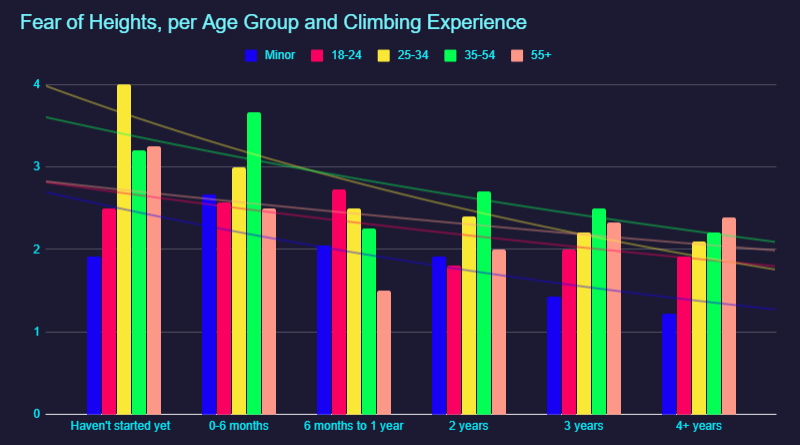It has taken us over half a year to collect the data used in this research.
To all 4600 participants that were kind enough to take the time to answer our questions: thank you!
The more than 40,000 data points they have collectively provided, have enabled us to gain valuable insights into fear of heights as it relates to age, gender and climbing experience, which we will now share.

Result #1: Climbing Decreases Fear Of Heights Significantly
Can exposure to heights build tolerance?
Or does it only increase your already present acrophobia?
That is one of the big questions this research provides an answer to.
Our data shows quite decisively that exposure to heights will over time increase tolerance for heights:
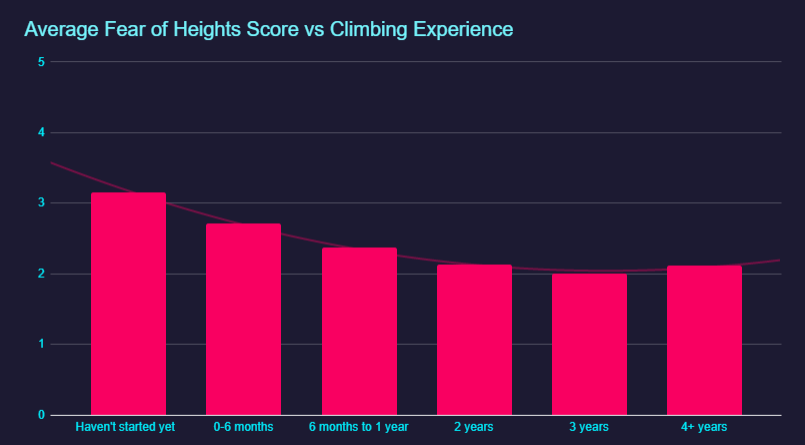
This data clearly shows that climbing decreases fear of heights. Most of the benefits of climbing for the reduction of fear of heights, are reaped in the first year of climbing. During this time the average fear of heights drops by 36,7%. Continuing to climb for the following three years will maintain to reduce the subjects fear of heights, albeit being less effective for each consecutive year.
Very experienced climbers, interestingly, are slightly more concerned about heights. This is possibily accounted for by the fact they they embark on riskier, higher climbs, e.g. when lead climbing a multi-pitch. A degree of fear of heights in these circumstances is definitely healthy – all experienced climbers have heard the adage “never fall on lead”.
Result #2: Understanding Your Climbing Gear Helps
Climbing equipment can seem complicated.
And climbers are all too aware that one faulty tied knot can have severe repercussions.
Knowing how to check your gear, how much weight climbing ropes are designed to be able to hold and how to tie in your harness are all things that are bound to have an influence on how safe you feel when you’re at a critical distance from the ground.
So, how exactly does familiarisation with your gear help you in regard to your fear of heights?
As it turns out:
Almost two thirds of climbers (64.9%) say that learning about their climbing gear has helped them overcoming their fear of heights.
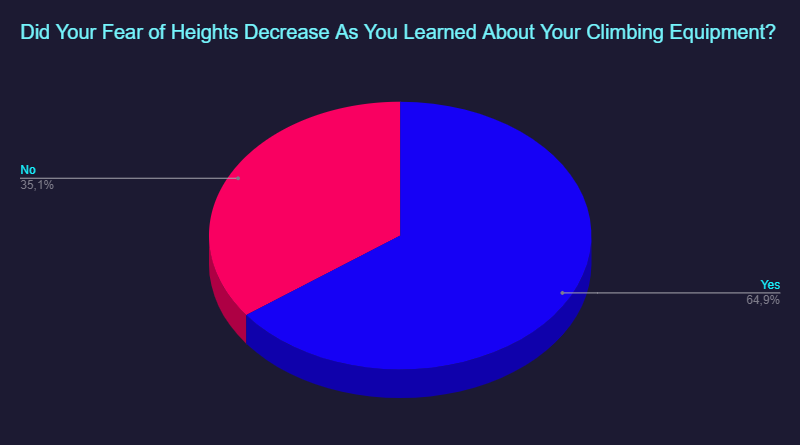
Result #3: People Who Start To Climb Explicity To Overcome Acrophobia Benefit (Almost) Just As Much
It may be natural for the average person to become less scared of heights as one begins to understand how safe the equipment is.
But it is not self evident that somebody who explicitly starts to climb in hopes of overcoming ones fear of heights, will also experience benefits from climbing in regards of ones acrophobia.
These people are likely to have a more profound fear of heights, as they have identified their problem and tried climbing as a solution to that problem.
That is why we asked all our participants what their reasons were to get into climbing in the first place.
Over 500 participants said that they explicitly got into climbing to overcome their fear of heights.
This enabled us to pair the data for all people who listed “To overcome my fear of heights” as a reason they got into climbing, with the data where they could indicate whether their fear of heights has in fact decreased.
The results were surprising:

As you can see, people who get into climbing as a solution to their acrophobia are just 0.5% less likely to see a reduction in their fear of heights than people are who got into climbing for any arbitrary reason.
The implication of this result is that climbing can be deployed as a way to overcome ones fear of heights, even when a person has themselves identified it as a problem he or she wants to fix. Additionally, their chances to actually benefit from climbing are very favourable, approaching a two thirds success rate. The difference between their success rate of acrophobia reduction and that of any other, is negligible.
Result #4: Youngster are Relatively Fearless; While People In Their Prime Are More Scared Than the Elderly
It may not come as a surprise to parents, because they have first hand experience of their children trying to climb everything remotely climbable.
But our results show that minors (under 18 years old) are significantly less scared of heights than adults are.
Interestingly, people in the age group of 25-34 are on average the most scared of heights. This may be explained by the fact that this group has a lot to lose, often having young children themselves for whom they are expected to care.
As these adults get older, the fear of heights diminishes again. Climbers that are no longer in their prime and seniors (55 years or older) show to have milder fear of heights, albeit still more present than in minors.
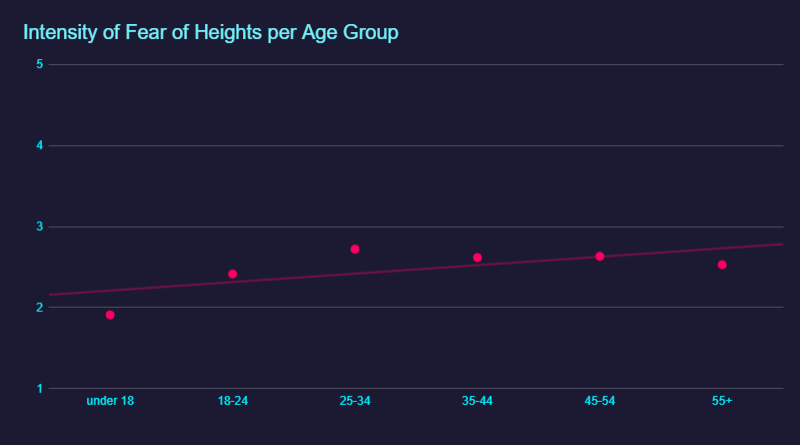
The point is even better illustrated when we put the same data in a different chart, comparing the subjective fear of heights score per age group, as a deviation from the mean.
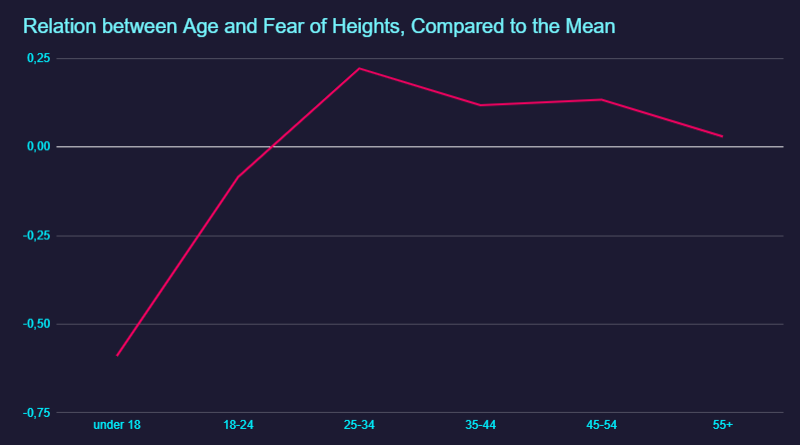
Result #5: Men Are Slightly More Scared Of Heights Than Women, But Slightly More Likely To Overcome Their Fear
Men, on average, are 6% more scared of heights than women are.
However, 67,1% of men acknowledged that learning the ropes of climbing and getting acquainted with the tools has decreased that fear of heights, which is 3.5% more than that of women.

BONUS: For the Data Nerds Out There..
Lastly, we went through the labourious task to differentiate the subjective Fear of Heights scores of our participants, for each age group, for each level of climbing experience.
While our data set of 4600 has given us reliable, representative information so far, please keep in mind that in order to calculate the chart below, we had to differentiate so much, that the data becomes a bit scarce for certain of these groups. In particular, the “6 months to 1 year” group for the older ages needs more data points to become reliable.
That’s why we’ve included the following chart as a bonus, and did not include it in the main research results.
